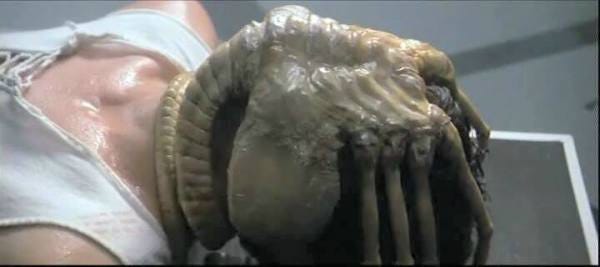By Daniel Snyder
There’s an inevitable obstacle that arises in the conceiving of fictional alien life: Our own inability to conceptualize life that is not, at least in some small way, a reflection of us. The “grays,” probably our most well-known fictional visitors, with their large heads and bulging eyes, are fairly obvious distortions of the standard human physique.
When Academy Award-winning Swiss artist H.R. Giger passed away on Monday, he left behind, among his endless menagerie of horrors across a wide array of media, including painting, film, sculpture, and music, one of the most unique depictions of alien life ever put to screen. The titular alien, heretofore referred to as the Xenomorph, from Ridley Scott’s 1979 science fiction horror classic, wasn’t inspired by the stars. Instead it came from deep within mankind (
sorry John Hurt) and somehow developed into something more alien and terrifying than anything from the unknown.
Unlike many of its galactic fellows, the Xenomorph doesn’t fly around in a spotless ship of unfathomable technology. Giger’s creature is a filthy, primal parasite whose very survival is contingent on it’s continued rape and exploitation of other species.
More optimistic conceptions of alien life involve two key traits. The first is a high level of technology which has not only allowed their race to travel great distances, but, more importantly, has freed them from the need for aggression. Prior to Alien, Close Encounters of the Third Kind became a critical and commercial hit behind the idea of a mysterious but ultimately friendly and benevolent alien visitors. They possessed a level of technology that not only allowed travel at great distances, but had seemingly allowed them to eliminate the need for violence against another species. The second key trait is expanded mental capacity or enlightenment through which the aliens have achieved interstellar cooperation with other races, such as in Star Trek’s universe of largely peaceful interspecies interaction, and/or psychic abilities. The idea of the enlightened alien is an inherently optimistic reflection of humanity. It is our best qualities extrapolated into the far future. Our best hope for ourselves.
Unlike many of its galactic fellows, the Xenomorph doesn’t fly around in a spotless ship of unfathomable technology. Giger’s creature is a filthy,
primal parasite whose very survival is contingent on it’s continued rape and exploitation of other species. If this sounds like a familiar concept, it’s because, at least according to Giger, it was an accurate, if a little pessimistic,
reflection of humanity’s most basic function. Throughout his career, Giger made a point of highlighting the dark side of the human life cycle so often worshipped as a source of hope and positivity. While we celebrated births and treasured our existence, Giger produced pieces like
Erotomechanics VII, which sapped thought and feeling from the act of reproduction and reduced them to what he saw as the truth: the cold, mechanical struggle to survive. To Giger, sex and birth could be pain and even kill. Every life, he posited in his piece
Birth Machine, carries the potential for suffering. In
Necronom IV, we see the phallus and the monster depicted as one, a fusion of a symbol of life with its inherent potential for pain and trauma. Giger’s message was very clear: That thing between your legs is also an instrument of evil.
None of this is meant to take away from what O’Bannon, Shusset, and Scott achieved with Alien — which made Scott a household name, earned back its budget 10 times over, and made a star out of Sigourney Weaver as much as the Xenomorph itself — but they were undeniably gifted a great treasure in Giger’s creation. While others looked to the stars for inspiration, the Xenomorph was dredged from the filthy and most basic truths of our existence, a look backwards at our primordial selves. Seeing that on screen was more terrifying than any green-skinned, antennae-sporting alien in a UFO.





















































